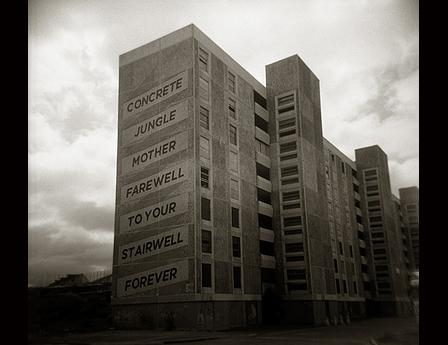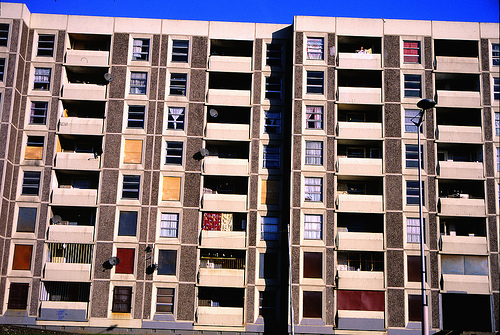Regeneration without end in Ballymun

Ballymun's first tenants moved into their new homes forty-five years ago, in August 1966. Described by environmental journalist Frank McDonald as the "worst planning disaster" in the history of the State, a comprehensive regeneration plan for the area swung into action in 1999. Paul Walsh traces the successes and failures of "one of the largest regeneration schemes in all of Europe".
When Ballymun’s flat complexes were built in the 1960s they were considered one of the finest examples of social housing in Europe. Prospective tenants had to attend an interview to obtain one and they had features such as central heating - at the time considered a luxury. However, civic and public amenities did not follow the new tenants and housing stock to Ballymun. There were plans for ten thousand feet of office accommodation, a cinema, dance hall, skating rink, restaurant, community centre, swimming pool and playgrounds. None of this materialised and Ballymun’s tenement refugees found that they were abandoned and ignored. The first tenants moved into the tower blocks in 1966; by 1974 a survey found that almost half the population wanted to leave.
Regeneration
With this historical context as the driving force, and following government approval in 1997, a regeneration programme to address the economic and social woes of Ballymun was undertaken. Dublin City Council (DCC) established a limited company known as Ballymun Regeneration Limited (BRL) to develop and implement a regeneration plan. A masterplan was drawn up in March 1999 after consultation with the local community. The then government adopted proposals which estimated the cost of implementing the regeneration works set out in the masterplan at €442 million. The plan set out to achieve a number of aims through its implementation. Alongside the transformation of the physical environment of the area, the regeneration also aimed to develop new civic and community facilities, new parks and infrastructure, while achieving economic development and social regeneration.
Achievements
According to a housing strategy report produced in September 2010, it is expected that all the replacement social housing will be completed by 2014. A range of civic and community projects completed as part of the regeneration have undoubtedly brought improvements to the area. A Civic Centre, which was originally planned for completion in 2001, was completed by a private developer in 2003. It is located on Main Street and now provides office accommodation for BRL, the Health Services Executive – Eastern Region and Dublin City Council, which has its North West Area office and a motor tax office in the building. The Ballymun Arts and Community Resource Centre (The Axis Arts Centre) was a community development project which was completed in 2011 and is located on Main Street beside the new Civic Centre. The facility includes a 211 – seat theatre, dance and recording studios, a conference centre, meeting and training rooms, subsidised offices for voluntary groups, a café bar and a crèche. A Sports and Leisure complex, incorporating a swimming pool, was completed in June 2005 at a cost of €22.6 million. Alongside these community facilities the long delayed arrival of IKEA to Ballymun happened in July 2009. The furniture superstore brought 500 jobs to a local area that has always suffered from above average unemployment. Research by the Ballymun Partnership in 2003 showed that the unemployment rate in Ballymun was three times the national average.

Delay, Disappointment and Death
Despite the success that the BRL can point to, this regeneration project has often been mired in controversy and has faced harsh criticism. The masterplan originally set 2006 as the target for completion of the physical regeneration of Ballymun. This date was pushed back to 2010, then 2012. A housing strategy document published by the BRL in 2010 further extended the date of completion. Their estimate for completion of the social housing element of the plan was 2014. According to a special report published by the Comptroller and Auditor General in 2007 on Ballymun Regeneration, there were numerous reasons for the delays. They identified the extended planning process, lack of mapping of utilities, enforced changes in demolition methods due to asbestos, and the demands of the consultation process with tenants.
Local TD Dessie Ellis of Sinn Féin has some sympathy for the problems faced by the BRL. “It was the biggest regeneration in Europe. So, I think these issues arose and remember it wasn’t as if you had a greenfield site, that you could go on and operate on to your hearts content. You were stuck in the middle of communities. So all these problems arose and health and safety became a big issue. To some extent I can understand some of it dragging on a bit. Although at this stage it’s gone on far too long.” Whether the delays were unavoidable or not, it was the residents of Ballymun that bore the brunt of the hardship it caused.
One young mother Tamlyn Caffrey, lived in Joseph Plunkett Tower from 1999 to 2010 with her three children. She actively battled to leave the Tower - which has still yet to be demolished - as she felt she “had to get out”. After being originally excited about the regeneration project, she soon felt that her new home would not materialise. “I was told originally that I would get a new house in 2010. As it went on and I was trying to push it and get out of there, I was told it would be 2013 or 2014.” The urgency for a move became greater when her daughter developed serious health problems that required a change of environment. “It was horrible. People were constantly getting access to the flat complex and going the toilet on the stairs or in the lifts; chutes were constantly set on fire. This was happening every day.” Though armed with documentation from her daughter’s doctor recommending she be rehoused, she still faced delays. Through determination coupled with some luck she secured a new home through Cluid Housing in Belmayne.
Not everyone was as lucky as Ms Caffrey. Rachel Peavoy, of Shangan Road, Ballymun, Dublin 9, was found dead in her flat on January 11, 2010. Ms Peavoy had died of hypothermia. An inquest into the death of the mother of two heard that she had contacted Dublin City Council in relation to the heating in her flat not working, but was told it would not be turned back on as a number of flats around her had been vacated and because regeneration was ongoing. For Mr. Ellis this is the human cost of the delays to the Ballymun Regeneration project. “We had the unfortunate situation with Rachel Peavoy who should have been moved 4 years prior. She was living in Shangan and who is to tell, but had she been moved, would it have happened?”
The social housing in Ballymun is not the only part of Ballymun’s regeneration that has yet to be completed. Planning permission for a 255,000 sq metre shopping centre complex in Ballymun Town Centre, to be known as Spring Cross, was granted to Treasury Holdings in 2009. The proposed scheme included 360 apartments, 60,000 square metres of retail, 35,000 square metres of offices and 11,000 square metres of other uses including a leisure and civic building with cinemas, bowling alleys, a public library and restaurants. It was announced that work would began on this in September 2010, with its completion by 2013. The development has failed to progress and with Treasury Holdings now dependant on NAMA for survival, the chances of its completion looks slim. Mr. Ellis is sceptical that any development will happen on the site in the near future. “We had some chance of getting the shopping centre developed down the road but if the Metro North plan does not go ahead this will be delayed for many, many years.”
The Future
According to Dublin City Council, of the original 30 tower blocks in Ballymun, nine remain. For those that remain the message from the BRL is that their wait is almost over. Eamonn Farrelly, chairman of Ballymun Regeneration Ltd, said the flats were being maintained and those in the almost-empty blocks “should be moved by the end of next year”. The regeneration of Ballymun is over budget, massively behind schedule and yet it still rumbles on. Local TD Dessie Ellis thinks there are other options available that will achieve the same outcome. “Well to be honest I don’t see any need for the regeneration to continue past the present schemes that have already been started, that is Shangan and Sillouge. When they are finished there are approx 250 or 260 people to be rehoused under the regeneration scheme. I think Dublin City Council should take control of this. Properties are being acquired very cheap now. In Ballymun you can purchase properties for between and €80,000 and €100,000. So, I cannot see a justification for continuing to pump money into the regeneration project when you can buy properties cheaper locally.”
However they decide to complete the project, Mr. Ellis admits that the people of Ballymun “feel let down”. Promises failed to be delivered on in the 1960s and 70s and despite some success by the BRL, Ballymun is an incomplete project. As Ireland’s austerity project rolls on, it's an open question whether will it take another generation before Ballymun finally gets the facilities that it deserves and has been long promised.
{jathumbnailoff}
Image top: Monosnaps.
Image centre: admanchester LRPS.
